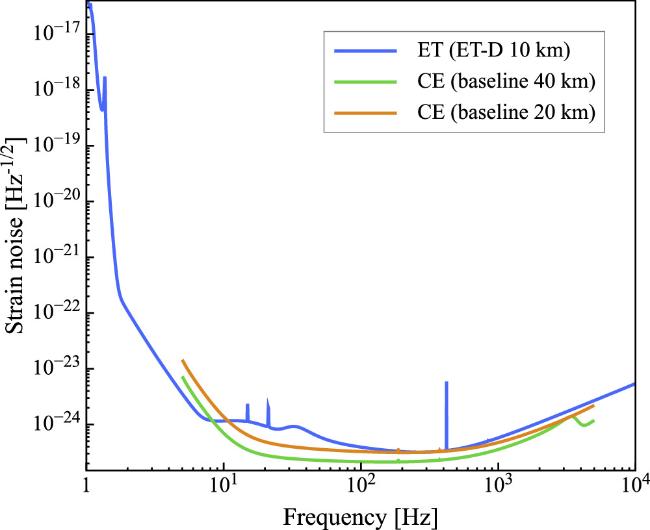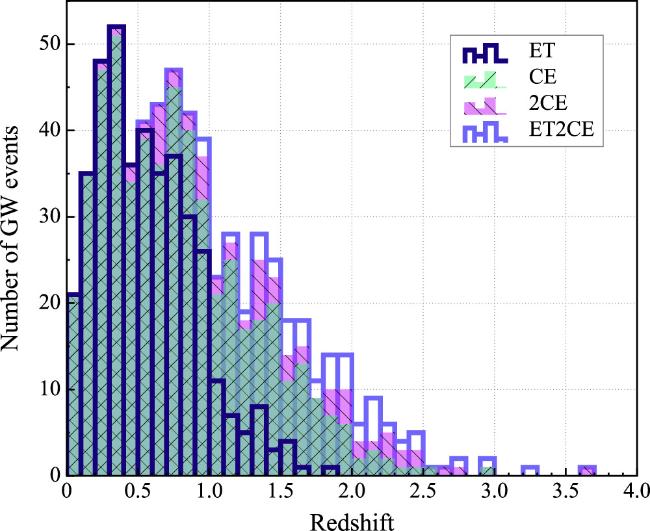1. Introduction
2. Methodology
2.1. Gravitational wave simulation
2.2. Other cosmological observations
2.3. Methods of constraining cosmological parameters
Figure 1. Sensitivity curves of the 3G GW detectors considered in this work. |
Table 1. The specific coordinate parameters considered in this work. |
| GW detector | φ(deg) | λ(deg) | γ(deg) | ζ(deg) |
|---|---|---|---|---|
| Einstein Telescope, Europe | 40.443 | 9.457 | 0.000 | 60 |
| Cosmic Explorer, USA | 43.827 | −112.825 | 45.000 | 90 |
| Cosmic Explorer, Australia | −34.000 | 145.000 | 90.000 | 90 |
Table 2. Numbers of GW standard sirens in cosmological analysis, triggered by THESEUS in synergy with ET, CE, 2CE, and ET2CE, respectively. |
| Detection strategy | ET | CE | 2CE | ET2CE |
|---|---|---|---|---|
| Number of GW standard sirens | 400 | 538 | 600 | 640 |
Figure 2. Redshift distributions of BNS detected by THESEUS in synergy with ET, CE, 2CE, and ET2CE for a 10-year observation. |
3. Results and discussion
Figure 3. Constraint results for the ΛCDM+Neff model from the CBS, CBS+ET, CBS+CE, CBS+2CE, and CBS+ET2CE data combinations. One-dimensional marginalized posterior distribution for Neff (left panel), and two-dimensional marginalized posterior contours (1σ and 2σ) in the H0–Neff and Ωm–Neff planes (right panel). |
Figure 4. Two-dimensional marginalized posterior contours (1σ and 2σ) in the Neff–${m}_{\nu ,{\rm{sterile}}}^{{\rm{eff}}}$, H0–${m}_{\nu ,{\rm{sterile}}}^{{\rm{eff}}}$, Ωm–${m}_{\nu ,{\rm{sterile}}}^{{\rm{eff}}}$ planes for the ΛCDM+Neff+${m}_{\nu ,{\rm{sterile}}}^{{\rm{eff}}}$ model from the constraints of the CBS, CBS+ET, CBS+CE, CBS+2CE, and CBS+ET2CE data combinations. |
Table 3. Fitting results of the ΛCDM+Neff model by using the CBS, CBS+ET, CBS+CE, CBS+2CE, and CBS+ET2CE data combinations. We quote ± 1σ errors for the parameters, but for the parameters that cannot be well constrained, we quote the 2σ upper limits. Here, H0 is in units of kms−1 Mpc−1. |
| Model | CBS | CBS+ET | CBS+CE | CBS+2CE | CBS+ET2CE |
|---|---|---|---|---|---|
| Ωbh2 | 0.02247 ± 0.00015 | 0.02248 ± 0.00011 | 0.02248 ± 0.00011 | 0.02248 ± 0.00011 | 0.02248 ± 0.00011 |
| Ωch2 | $0.122{0}_{-0.0028}^{+0.0017}$ | 0.1217 ± 0.0017 | 0.1217 ± 0.0016 | 0.1217 ± 0.0016 | 0.1217 ± 0.0016 |
| 100θMC | $1.0404{6}_{-0.00037}^{+0.00043}$ | 1.04050 ± 0.00036 | $1.0405{0}_{-0.00035}^{+0.00034}$ | 1.04049 ± 0.00035 | 1.04050 ± 0.00034 |
| τ | $0.055{8}_{-0.0083}^{+0.0074}$ | $0.055{8}_{-0.0082}^{+0.0075}$ | $0.055{9}_{-0.0082}^{+0.0074}$ | $0.055{9}_{-0.0082}^{+0.0075}$ | $0.055{8}_{-0.0082}^{+0.0072}$ |
| ns | $0.969{7}_{-0.0057}^{+0.0046}$ | 0.9696 ± 0.0030 | $0.969{6}_{-0.0031}^{+0.0030}$ | 0.9697 ± 0.0030 | 0.9697 ± 0.0029 |
| ${\rm{ln}}(1{0}^{10}{A}_{s})$ | $3.05{1}_{-0.018}^{+0.016}$ | 3.050 ± 0.016 | 3.050 ± 0.016 | 3.050 ± 0.016 | 3.050 ± 0.016 |
| σ8 | $0.817{7}_{-0.0101}^{+0.0083}$ | $0.817{0}_{-0.0081}^{+0.0082}$ | 0.8169 ± 0.0078 | 0.8171 ± 0.0079 | 0.8169 ± 0.0077 |
| Ωm | $0.307{7}_{-0.0061}^{+0.0060}$ | 0.3071 ± 0.0038 | $0.307{1}_{-0.0036}^{+0.0035}$ | 0.3071 ± 0.0035 | $0.307{0}_{-0.0035}^{+0.0034}$ |
| H0 | $68.67{0}_{-1.020}^{+0.640}$ | $68.67{1}_{-0.055}^{+0.057}$ | $68.67{1}_{-0.057}^{+0.056}$ | $68.67{1}_{-0.054}^{+0.052}$ | $68.67{2}_{-0.050}^{+0.052}$ |
| Neff | < 3.464 | 3.209 ± 0.060 | 3.209 ± 0.056 | $3.21{0}_{-0.056}^{+0.055}$ | $3.20{8}_{-0.055}^{+0.054}$ |
| | |||||
| ΔNeff > 0 | . . . | 2.717σ | 2.911σ | 2.929σ | 2.945σ |
| σ(Ωm) | 0.00605 | 0.00380 | 0.00355 | 0.00350 | 0.00345 |
| σ(H0) | 0.8300 | 0.0560 | 0.0565 | 0.0530 | 0.0510 |
| ϵ(Ωm) | 1.966% | 1.237% | 1.156% | 1.140% | 1.124% |
| ϵ(H0) | 1.209% | 0.082% | 0.082% | 0.077% | 0.074% |
Table 4. Fitting results of the ΛCDM+${N}_{{\rm{eff}}}+{m}_{\nu ,{\rm{sterile}}}^{{\rm{eff}}}$ model by using the CBS, CBS+ET, CBS+CE, CBS+2CE, and CBS+ET2CE data combinations. We quote ± 1σ errors for the parameters, but for the parameters that cannot be well constrained, we quote the 2σ upper limits. Here, H0 is in units of kms−1Mpc−1 and ${m}_{\nu ,{\rm{sterile}}}^{{\rm{eff}}}$ is in units of eV. |
| Model | CBS | CBS+ET | CBS+CE | CBS+2CE | CBS+ET2CE |
|---|---|---|---|---|---|
| Ωbh2 | $0.0224{7}_{-0.00016}^{+0.00015}$ | 0.02249 ± 0.00012 | 0.02249 ± 0.00012 | 0.02249 ± 0.00012 | 0.02249 ± 0.00012 |
| Ωch2 | $0.119{8}_{-0.0031}^{+0.0036}$ | $0.119{3}_{-0.0018}^{+0.0033}$ | $0.119{3}_{-0.0017}^{+0.0032}$ | $0.119{5}_{-0.0017}^{+0.0031}$ | $0.119{4}_{-0.0017}^{+0.0030}$ |
| 100θMC | $1.0405{9}_{-0.00033}^{+0.00047}$ | $1.0407{1}_{-0.00035}^{+0.00041}$ | $1.0407{1}_{-0.00035}^{+0.00040}$ | $1.0407{0}_{-0.00036}^{+0.00040}$ | $1.0407{1}_{-0.00036}^{+0.00039}$ |
| τ | $0.056{1}_{-0.0083}^{+0.0073}$ | $0.056{6}_{-0.0082}^{+0.0074}$ | $0.056{6}_{-0.0082}^{+0.0074}$ | $0.056{8}_{-0.0083}^{+0.0074}$ | $0.056{9}_{-0.0083}^{+0.0074}$ |
| ns | $0.968{1}_{-0.0065}^{+0.0047}$ | 0.9684 ± 0.0033 | 0.9684 ± 0.0033 | 0.9684 ± 0.0033 | $0.968{4}_{-0.0032}^{+0.0033}$ |
| ${\rm{ln}}(1{0}^{10}{A}_{s})$ | $3.04{8}_{-0.018}^{+0.016}$ | $3.04{8}_{-0.017}^{+0.016}$ | $3.04{8}_{-0.017}^{+0.016}$ | 3.048 ± 0.016 | 3.048 ± 0.016 |
| σ8 | $0.79{6}_{-0.014}^{+0.024}$ | $0.79{5}_{-0.012}^{+0.022}$ | $0.79{5}_{-0.012}^{+0.022}$ | $0.79{6}_{-0.012}^{+0.021}$ | $0.79{6}_{-0.012}^{+0.022}$ |
| Ωm | 0.3114 ± 0.0064 | $0.309{6}_{-0.0052}^{+0.0032}$ | $0.309{6}_{-0.0050}^{+0.0032}$ | $0.309{7}_{-0.0049}^{+0.0033}$ | $0.309{6}_{-0.0048}^{+0.0033}$ |
| H0 | $68.15{0}_{-1.000}^{+0.500}$ | $68.15{6}_{-0.053}^{+0.055}$ | $68.15{6}_{-0.053}^{+0.054}$ | $68.15{6}_{-0.053}^{+0.054}$ | $68.15{6}_{-0.050}^{+0.054}$ |
| Neff | < 3.446 | $3.14{8}_{-0.094}^{+0.039}$ | $3.14{8}_{-0.090}^{+0.040}$ | $3.15{0}_{-0.089}^{+0.043}$ | $3.15{0}_{-0.089}^{+0.042}$ |
| ${m}_{\nu ,{\rm{sterile}}}^{{\rm{eff}}}$ | < 0.5789 | < 0.4842 | < 0.4772 | < 0.4321 | < 0.4226 |
| | |||||
| ΔNeff > 0 | ... | 1.085σ | 1.133σ | 1.169σ | 1.169σ |
| σ(Ωm) | 0.00640 | 0.00420 | 0.00410 | 0.00410 | 0.00405 |
| σ(H0) | 0.7500 | 0.0540 | 0.0535 | 0.0535 | 0.0520 |
| ϵ(Ωm) | 2.055% | 1.357% | 1.324% | 1.324% | 1.308% |
| ϵ(H0) | 1.101% | 0.079% | 0.078% | 0.078% | 0.076% |







